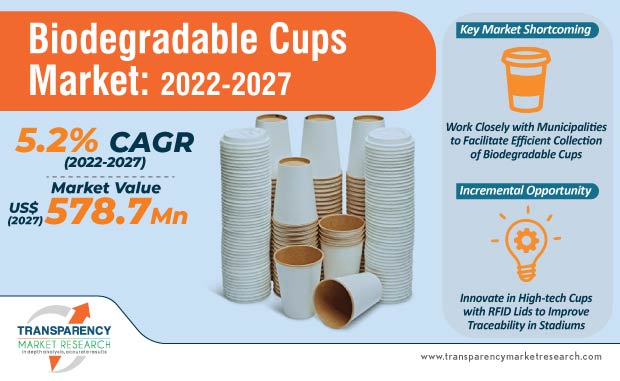
Renewable Paper Cups Provide Convenience in a Sustainable Way
There is strong demand for eco-friendly solutions in the food service packaging landscape. Consumers demand convenience, but in a sustainable way. The global sales of food service packaging is estimated to reach ~US$ 31 billion by the year 2027. This is why manufacturers in the biodegradable cups landscape are innovating on compostable and recyclable packaging solutions.
Market players are introducing renewable paperboard designs for paper cups that can be efficiently recycled. This novel material used for cups is suitable for hot and cold beverages, as well as for ice cream packaging. This paperboard is manufactured without a plastic coating layer. Thus, full fiber recovery helps reduce the environmental footprint by almost half as compared to conventional plastic cups.
The introduction of recyclable paper cups helps comply with strict environmental regulations, as governments in many countries are introducing bans on plastic usage. For instance, in May 2019, Stora Enso – a paper and pulp company, announced the launch of Cupforma Natura Solo™ – a high-quality renewable paperboard for paper cups.

Request a sample to get extensive insights into the Biodegradable Cups Market https://www.transparencymarketresearch.com/sample/sample.php?flag=S&rep_id=73232
Manufacturers Incorporate Water-soluble Coatings in Biodegradable Cups
The growth of the food service and packaging industry is triggering growth for the biodegradable cups market, which currently has a global production volume of ~149 billion units (2018). Manufacturers generally use plastic barriers against moisture, oil, grease, and heat in cups. Since this practice is not environmentally-friendly, market players are introducing water-based compostable coatings in biodegradable cups.
Biodegradable cups made from water-soluble coating help in easy disposal and can be effectively recycled. This environmental food grade barrier coating solves the issue against water, grease, and heat, for stakeholders in the food and beverage industry. To increase application in the food and beverage industry, manufacturers are improving biodegradable cups with value-added features such as heat resistance for oven applications, heat sealing, and water-based elements that pose no risk for human health. As such, manufacturers in the biodegradable cups landscape are innovating on new paper composites that do not require a barrier in cups, allowing them to biodegrade and be recycled easily.
Ground-level Initiatives Help Overcome Limitations of Recycling Infrastructure
The biodegradable cups market is highly fragmented, which is creating opportunities for emerging manufacturers to enter the market. However, established and emerging market players need to tackle the limitations of the existing recycling infrastructure. Although plastic and fiber materials in biodegradable cups can be recycled when separated, these materials cannot be easily recycled, since there are only few strong incentives for recyclers to recover the materials.
As such, market players are rolling out the scout’s honor system to efficiently collect reusable cups for further treatment. For example, in March 2019, Starbucks – an American coffee company, announced the exploration of next-generation recycling and composting technologies, and is working closely with municipalities to increase the acceptance of biodegradable cups.
Another innovation in the biodegradable cups landscape is the development of high-tech cups with RFID (Radio Frequency Identification) lids to manage the inventory of reusable cups and improve traceability in complicated venues such as stadiums.
Stuck in a neck-to-neck competition with other brands? Request a custom report on Biodegradable Cups Market https://www.transparencymarketresearch.com/sample/sample.php?flag=CR&rep_id=73232
- According to Transparency Market Research’s latest market report on the biodegradable cups market for the historical period of 2014-2018 and forecast period of 2019-2027, the increased demand for food, beverages, and consumer packaging is estimated to drive the biodegradable cups market. Globally, revenue generated by the biodegradable cups market has been estimated to be around 390 Mn in 2019. The biodegradable cups market is expected to expand at a CAGR of ~5% in terms of value throughout the forecast period.
- Increasing awareness regarding the adverse effects of plastic on the environment has led to the formation of stringent regulations for single-use plastic. These regulations have led to an increase in the consumption of biodegradable cups amongst consumers.
- Consumers and end users are aware of the negative impact of plastic on the environment. Specific steps are being adopted by governments to reduce the usage of plastic, which has resulted in the ban of single-use plastic in several countries. Many institutions and companies are trying to develop different products that could replace traditionally used plastics.
- Plastic cups and their lining are made from oil, which is a nonrenewable resource. The fact that manufacturing plastic requires a non-renewable resource results in the depletion of Earth’s resources, which is already limited and cannot be overlooked.
- Biodegradable cups are made from plants such as sugarcane, corn, and others, which are renewable sources, unlike conventionally used petroleum-based plastic cups. They are an ecofriendly and sustainable, which has made them a better alternative for consumers and end users to embrace.
- Utilizing biodegradable cups will result in a reduction in the amount of waste dumped into landfills and oceans.
- The production of bioplastics such as PLA uses 65% less energy in comparison to the ones created by raw petroleum.
- All the above factors are contributing to the high growth of the biodegradable cups market.





